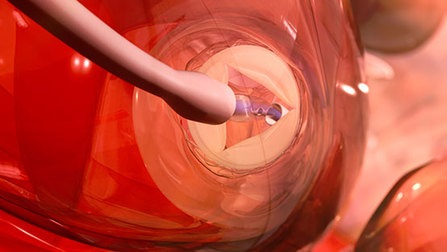
Transcatheter aortic valve implantation (TAVI) was found to be non-inferior to surgery for all-cause mortality at one year among patients aged 70 years or older with severe, symptomatic aortic stenosis and moderately increased operative risk according to findings of the UK TAVI trial, published in the Journal of the American Medical Association (JAMA) this month.
The study, a randomised clinical trial, found that among 913 patients at moderately increased operative risk due to age or comorbidity, all-cause mortality at one year was 4.6% with TAVI versus 6.6% with surgery. Previous studies have shown that TAVI is a safe and effective treatment for people who are not eligible for surgical aortic valve replacement (SAVR) or among those at high operative risk. However, UK TAVI included patients who were at lower risk and suitable for either procedure.
Lead author of the study, William Toff (University of Leicester, Leicester, UK), said: “It is great news for patients that TAVI is just as safe and effective as surgery even in patients at lower operative risk. This procedure is much less invasive than conventional approaches. People who would otherwise require open-heart surgery can have this procedure, and as it has a faster recovery time it means a shorter stay in hospital for patients.”
Conducted at 34 centres across the UK, the UK TAVI trial enrolled patients between April 2014 and April 2018. Patients were randomised to either TAVI using a CE mark-approved device (n=458) or SAVR (n=455), with a primary endpoint of all-cause mortality at one year.
Investigators reported that among 913 patients randomised to either TAVI or SAVR, 912 (99.9%) completed follow-up and were included in the non-inferiority analysis. At one year, there were 21 deaths (4.6%) in the TAVI group and 30 deaths (6.6%) in the surgery group, the investigators report. Of 30 prespecified secondary outcomes reported, 24 showed no significant difference at one year, the investigators add.
TAVI was associated with significantly shorter post-procedural hospitalisation (a median of three days versus eight days, while there were also significantly fewer major bleeding events after TAVI compared with surgery (7.2% vs. 20.2%). However, the TAVI group did see significantly more vascular complications (10.3% vs 2.4%), conduction disturbances requiring pacemaker implantation (14.2% vs 7.3%), and mild (38.3% vs 11.7%) or moderate (2.3% vs 0.6%) aortic regurgitation.
“These are extremely encouraging results after one year,” adds Toff. “However, we shall continue to monitor the participants for at least five years to ensure no late differences in the groups emerge and to assess the durability of the TAVI valves. We hope to publish the five-year results by the end of next year. In the meantime, patient-specific treatment recommendations should continue to be made by a multi-disciplinary heart team.”













